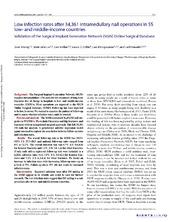| dc.contributor.author | Young, Sven | en_US |
| dc.contributor.author | Lie, Stein Atle | en_US |
| dc.contributor.author | Hallan, Geir | en_US |
| dc.contributor.author | Zirkle, Lewis G. | en_US |
| dc.contributor.author | Engesæter, Lars B. | en_US |
| dc.contributor.author | Havelin, Leif Ivar | en_US |
| dc.date.accessioned | 2014-02-10T10:54:14Z | |
| dc.date.available | 2014-02-10T10:54:14Z | |
| dc.date.issued | 2011-12 | eng |
| dc.Published | Acta Orthopaedica 82(6): 737–743 | eng |
| dc.identifier.issn | 1745-3674 | |
| dc.identifier.uri | https://hdl.handle.net/1956/7775 | |
| dc.description.abstract | Background: The Surgical Implant Generation Network (SIGN) supplies intramedullary (IM) nails for the treatment of long bone fractures free of charge to hospitals in low- and middle-income countries (LMICs). Most operations are reported to the SIGN Online Surgical Database (SOSD). Follow-up has been reported to be low, however. We wanted to examine the pattern of follow-up and to assess whether infection rates could be trusted. Patients and methods: The SOSD contained 36,454 IM nail surgeries in 55 LMICs. We excluded humerus and hip fractures, and fractures without a registered surgical approach. This left 34,361 IM nails for analysis. A generalized additive regression model (gam) was used to explore the association between follow-up rates and infection rates. Results: The overall follow-up rate in the SOSD was 18.1% (95% CI: 17.7–18.5) and national follow-up rates ranged from 0% to 74.2%. The overall infection rate was 0.7% (CI: 0.6–0.8) for femoral fractures and 1.2% (CI: 1.0–1.4) for tibial fractures. If only nails with a registered follow-up visit were included (n = 6,224), infection rates were 3.5% (CI: 3.0–4.1) for femoral fractures and 7.3% (CI: 6.2–8.4) for tibial fractures. We found an increase in infection rates with increasing follow-up rates up to a level of 5%. Follow-up above 5% did not result in increased infection rates. Interpretation: Reported infection rates after IM nailing in the SOSD appear to be reliable and could be used for further research. The low infection rates suggest that IM nailing is a safe procedure also in low- and middle-income countries. | en_US |
| dc.language.iso | eng | eng |
| dc.publisher | Informa Healthcare | eng |
| dc.relation.ispartof | <a href="http://hdl.handle.net/1956/7782" target="blank">Orthopaedic Trauma Surgery in Low-Income Countries. Follow-up, Infections and HIV</a> | eng |
| dc.rights | Attribution-NonCommercial CC BY-NC | eng |
| dc.rights.uri | http://creativecommons.org/licenses/by-nc/3.0/ | eng |
| dc.title | Low infection rates after 34,361 intramedullary nail operations in 55 low- and middle-income countries. Validation of the Surgical Implant Generation Network (SIGN) Online Surgical Database | en_US |
| dc.type | Peer reviewed | |
| dc.type | Journal article | |
| dc.description.version | publishedVersion | en_US |
| dc.identifier.doi | https://doi.org/10.3109/17453674.2011.636680 | |
| dc.identifier.cristin | 905141 | |
| dc.source.journal | Acta Orthopaedica | |
| dc.source.40 | 82 | |
| dc.source.14 | 6 | |
| dc.source.pagenumber | 737-743 | |

